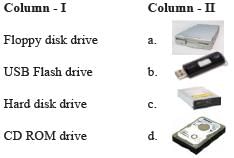Olympiad Test: Fundamentals Of Computer - 2 - Class 6 MCQ
20 Questions MCQ Test - Olympiad Test: Fundamentals Of Computer - 2
A ______ operating system allows more than one user to use the computer at the same or different times.
A business card reader uses ______ technology to convert text on business card to typed text on the computer.
Which of the following is a better quality dot matrix printer?
Which of the following is NOT a type of monitor?
Which of the following is a type of nonimpact printer?
Which of the following is NOT a secondary storage medium on a computer?
What is the difference between volatile and non-volatile memory?
BIOS of a computer is stored in ______.
The device shown in the picture is ______.

I have a large video around 0.4 GB size which I want to copy from my laptop to my desktop. Which of the following storage medium is best suited for transferring the video to the desktop computer?
Arrange the following units of memory from the smallest to the largest.
1 nibble, 1 terabyte, 1byte, 1 petabyte, 1 bit, 1 exabyte
SATA, PATA, Barracuda are examples of ___.
I have an image file of 1.345 MB. I am trying to copy it in a 3.5” floppy disk. Every time it gives an error message indicating it is unable to copy the file due to some specific reason. What might be the reason?
Arrange the following units of memory in decreasing order of the sizes.Nibbles, Terabyte, Zettabyte, Gigabyte, Yottabyte, Bit

















